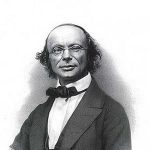Magnetic Personality: Wilhelm Weber
Do you know how to measure magnetic flux? The unit of measurement to describe magnetic flux is a “weber.” You may not have known, but this unit is a tribute to Wilhelm Weber, a truly magnetic personality from the early 1800s who had a hand in some of the most significant breakthroughs within magnetism and electricity.
Early Life
Wilhelm was born October 24, 1804 in Wittenberg, Germany into a family of 12 children. His two brothers, Ernst Heinrich Weber and Eduard Friedrich Weber were his first study partners— often completing scientific research together. Their studies became more than just child’s play, though — Weber published his work on wave theory with Ernst in 1825 and a treatise on the mechanics of walking with Eduard in 1833.
Weber received his early education from his father, a theology professor, until he attended grammar school and university in Halle. There, he studied natural philosophy, obtained his doctorate in 1826, and was appointed as an extraordinary professor of natural philosophy.
Magnetic Work
In 1831, Weber accepted a professorship at the University of Göttingen and found a new study partner in Carl Fredrich Gauss. Weber’s teaching style was much like his own studies—he was very hands-on and often encouraged his students, free of charge, to experiment with the lessons learned in his class in the college laboratory.
Besides working at the same University, what brought Gauss and Weber together was their shared interest and focus on getting accurate measurements. In fact, Weber and Gauss developed and enhanced various devices for sensitively detecting and measuring magnetic fields and electrical currents. In 1833, they built one of the world’s first working electrical telegraphs with a galvanometer as the receiver. The telegraph stretched nearly a mile between Weber’s physics laboratory and the astronomical observatory where Gauss spent most of his time. The pair also studied terrestrial magnetism, coordinating measurement efforts at magnetic surveying stations across the globe.
Weber also enhanced the electrodynamometer, which could measure electric current, voltage, or power through the interaction of magnetic fields of two coils. Using this device, Weber validated Andre-Marie Ampere’s force law, though these findings weren’t published until 1846 when it was also expanded on and accompanied by Weber’s generalized electrical law. In the early 1830s, Gauss developed a system of magnetic units expressed in length, mass, and time with Weber developing a similar system around 1840. Later, in the 1860s, an official Committee on Electrical Standards, formed by the British Association for the Advancement of Science, adopted the two systems as the foundation for units and definitions, while adding new ones.
This partnership had effects lasting even today as they established units and definitions that could be used consistently and simultaneously. These units and terms are still used today to describe concepts in the study of electricity and magnetism.
Later Life
In 1837, Weber was infamously dismissed from the University of Göttingen on political grounds, so he traveled to England. He came back to Germany shortly after, however, and remained there for his later life. In 1843, he was appointed as a professor of physics at the University of Leipzig. Six years later, he returned to Göttingen to teach in the same position he held back in 1826. He had a short stint as the director of the university’s astronomical laboratory in 1855, but he spent his later years continuing his electricity and magnetism work.
It was during this time that he also worked on the ratio between the electrodynamic and electrostatic units of charge and indicated it was approximately the speed of light. This would later be used by James Clerk Maxwell in his electromagnetic theory. Weber was recognized for his work during his lifetime, receiving honorary titles and awards in several countries. In 1855, he was elected a foreign member of the Royal Swedish Academy of Sciences. Weber died on June 23, 1891 at 86 years old, after living a very successful life.
Learn More With Apex Magnets
For more blog posts about magnetic personalities through the ages, check out these blogs.

